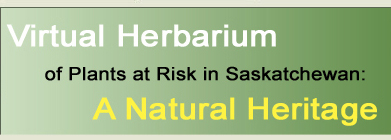|
| Erigeron radicatus
Hook. |
|
| |
| TAXONOMY |
| |
| Family: |
Asteraceae or Compositae |
| Genus: |
Erigeron |
| |
| Species Synonyms: |
none |
| Common Names: |
dwarf fleabane
taproot fleabane |
| |
| DISTRIBUTION |
| |
| Canada: |
Alberta – southwestern Saskatchewan |
| Saskatchewan: |
southwestern Saskatchewan; Cypress Hills –
Wood Mountain, Rockglen |
| Ecoregion: |
Cypress Upland, Mixed Grassland |
| |
| HABITAT |
| |
| Saskatchewan: |
sandy dry soil or eroded, often
cobbly grassland slopes and flats |
| Associated species: |
Astragalus sp.,
Cerastium arvense, Chamaerhodos erecta, Cryptantha celosioides, Ericameria
nauseosus var. nauseous, Erigeron compositus, Eriogonum flavum,
Gutierrezia sarothrae, Hymenoxys richardsonii, Iva axillaris, Lesquerella
arenosa, Machaeranthera grindelioides var. grindelioides, Musineon
divaricatum, Oenothera caespitosa, Penstemon nitidus, Symphyotrichum boreale |
| |
| RARITY STATUS |
| |
Provincial
Status According
to Harms (2003): |
Vulnerable |
| Nature Conservancy
Status: |
G3 N2 S2 |
Saskatchewan
Species at
Risk Status: |
None |
| COSEWIC Status:
|
Not at risk |
| |
| Erigeron radicatus
is vulnerable because it is somewhat regionally restricted to the southwest
corner of the province. Some populations are small and may be vulnerable
to changes in habitat due to agriculture or development. |
| |
| SPECIES
DESCRIPTION |
| |
| * Erigeron radicatus
may intergrade with E. ochroleucus var. scribneri. The
caudex is well-developed in E. ochroleucus but not in
E. radicatus. |
| |
| Height: |
3 – 10 cm tall |
| Roots: |
taproot deep |
| Stems: |
caudex branched; stems scapose, hirsute |
| Leaves: |
mostly basal, occasionally few reduced cauline;
basal leaves 1 – 3.5 cm long, 1 – 2 mm wide, linear to narrowly
oblanceolate, glabrous to finely pubescent at base, margins ciliate; cauline
leaves if present, 2 – 3, linear, pubescent |
| Inflorescence: |
heads few to solitary, to 1.2 cm across; involucre
~ 5 mm long, lanceolate to oblong or elliptic, greyish, short-villose, margin
scarious |
| Flowers: |
ligulate florets 20 – 50, 5 – 8 mm
long, to 2 mm broad, white; tubular florets yellow |
| Fruits: |
pappus double, inner series of 6 – 12 fragile
bristles, outer series of fine setae |
| |
| ERIGERON
SPECIES FOUND IN SASKATCHEWAN |
| |
| 1 Leaves dissected |
E. compositus |
| 1 Leaves not dissected |
2 |
| |
|
2 Rays absent or inconspicuous (<
6 mm; if longer than 6 mm, < 1 mm wide)
|
3 |
| 2 Rays present (> 6 mm) |
9 |
| |
|
| 3 Involucre glabrous |
Conyza canadensis var. canadensis |
| 3 Involucre pubescent and/or glandular |
4 |
| |
|
| 4 Involucre glandular, may be sparsely
pubescent |
5 |
| 4 Involucre pubescent, but not glandular |
6 |
| |
|
| 5 Several to many heads; densely glandular
involucre |
E. acris ssp. politus |
| 5 Head solitary; somewhat glandular
involucre |
E. acris ssp. debilis |
| |
|
| 6 Pappus double |
7 |
| 6 Pappus single |
8 |
| |
|
| 7 Phyllary hairs flattened, stem hairs
appressed |
E. strigosus var. septentrionalis |
| 7 Phyllary hairs terete, stem hairs
appressed to ascending |
E. strigosus var. strigosis |
| |
|
| 8 Leaves shorter than peduncles of
flower heads; inflorescence corymbose, occasionally solitary; rayless pistillate
flowers present between ray and disc flowers |
E. elatus |
| 8 Leaves sometimes exceeding lower
heads in inflorescence; inflorescence racemose; occasionally solitary; rayless
pistillate flowers absent |
E. lonchophyllos |
| |
|
| 9 Plants < 20 cm high; heads few
to solitary |
10 |
| 9 Plants > 20 cm high; heads 2
– many |
12 |
| |
|
| 10 Leaves usually basal only; flowers
white |
E. radicatus |
| 10 Cauline leaves present; flowers
yellow or purple (if white, leaves 3 – 7 cm long) |
11 |
| |
|
| 11 Leaves 3 – 7 cm long, with
1 – 3 cauline leaves; flowers yellow to white or lavender |
E. ochroleucus var. scribneri |
| 11 Leaves 1 – 3 cm long, many
cauline leaves; flowers purple |
E. hyssopifolius |
| |
|
| 12 Stems scapose or subscapose |
E. pumilus |
| 12 Stems distinctly leafy, often reduced
upwards |
13 |
| |
|
| 13 Ray florets coloured |
14 |
| 13 Ray flowers white |
16 |
| |
|
| 14 Stem leaves largest at the middle
of stem |
E. hyssopifolius |
| 14 Stem leaves reduced upwards |
15 |
| |
|
| 15 Leaves clasping and auriculate |
E. philadelphicus var. philadelphicus |
| 15 Leaves not clasping or auriculate |
E. glabellus var. glabellus |
| |
|
| 16 Stem leaves largest at the middle
of stem |
E. hyssopifolius |
| 16 Stem leaves reduced upwards |
17 |
| |
|
| 17 Perennial with woody caudex, tough
rhizome, or thick taproot |
18 |
| 17 With neither deep-well developed
rhizomes nor woody caudices, at most a short rhizome or stolons |
19 |
| |
|
| 18 Caudex; stem leaves 5 – 7 |
E. glabellus var. glabellus |
| 18 Thick taproot; stem leaves >
10 |
E. caespitosus |
| |
|
| 19 Pappus of ray and disc florets
unlike (pappus of rays single) |
E. annuus |
| 19 Pappus of ray and disc florets
alike |
E. asper |
|






